Auction websites have been around over the years and have gained popularity giving users the opportunity to use a platform for buying and selling different products based on a bidding system. Others have seen the idea to build your own auction website as a good strategy, especially when starting a business due to its ability to gain a huge following.
Statistics show that 12% of users with an age of 18 to 29 years, and 11% of users ages 30 to 59 years participate in daily auctions.
In 2017 IBISWorld noted that the annual revenue of the online auction business is estimated at $394 billion and is going to increase at 13.3% annually.
In 2020, the Industry Statistics and Market Research USA forecasts online auctions will grow in the next 5 years. This goes to show that auction websites have been a huge part of our lives whether it is on the buyer or seller side.
Table of Contents
- 1 Why do online auction websites become so popular?
- 2 Is it worth developing an auction website like eBay?
- 3 How to build an online auction site: your step by step guide
- 4 Download our detailed estimate: How to Build Your Own Auction Website Like eBay
- 5 How much does it cost to build an auction website?
- 6 Our experience in auction development
Why do online auction websites become so popular?
It is worth mentioning that a lot of people – both buyers and sellers, benefit from auction websites. Users are able to buy and sell the products on a wider market reaching like-minded people. It is proved by an online survey that showed that 47-49% of adult users in Great Britain visit auction sites regularly (once a week or more often). And these numbers are the same for Germany.
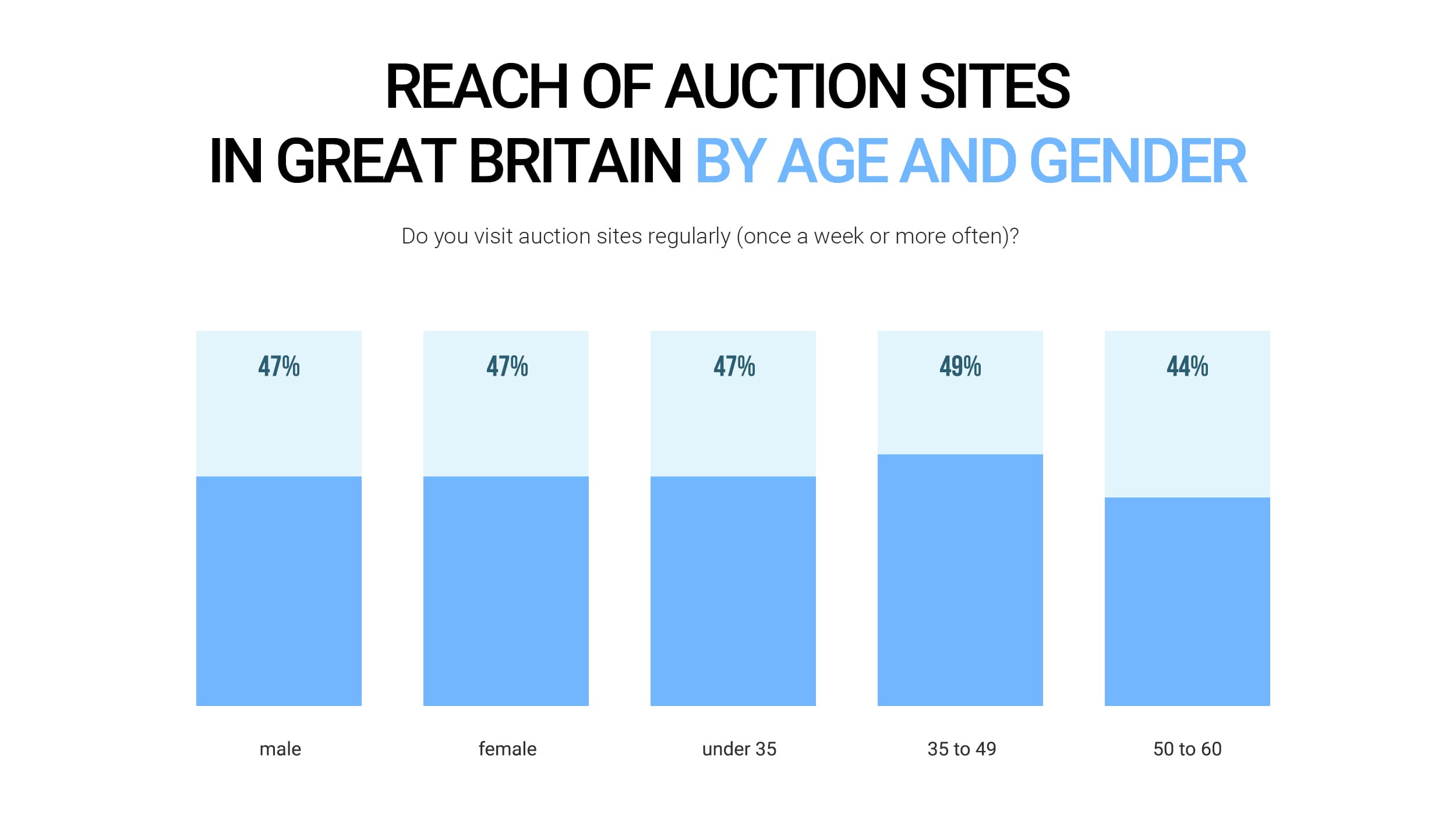
For someone creating an auction website, building it gives you the opportunity to sell products to the highest bidder without the help of middlemen. This means avoiding arranger fees, and lock-in of different auction platforms.
In addition to that, the auction website gives a wide range of benefits such as time-stamped electronic bid forms, online searches that have the ability to throw up listings of the latest items sold on auction, and more.
It is inevitable that online auctions have captured the interest of many internet users that’s why entrepreneurs and start-up businesses have begun developing sites similar to eBay. Let us see whether it is worthy to create your own auction site and if it can be possible to garner the same success as eBay.
Is it worth developing an auction website like eBay?
On September 3, 1995, Pierre Omidyar started a buy and sell website out of a hobby that is then made known today as eBay. What started as a simple online auction company, became popular for many users as it was a major source of income not only to Pierre but also to the many users that discovered it.
In the second quarter of 2020, the revenue of eBay has already reached 2.86 billion U.S. dollars translating to a 770 million U.S. dollar net income. Compared to the 576 million U.S. dollar net income in the corresponding quarter of the preceding year, auction websites have continuously proved their growing and ever-flourishing market.

How do online auctions like eBay make money?
A well-thought-of revenue model allows for an effective monetization strategy. eBay earns money by implementing fees such as the following:
☑️Fees for Sellers
– sellers ought to be charged a percentage for each sale. This is the main profit generator for eBay and other auction websites.
☑️Insertion Fees
– sellers are to be charged for providing their goods per classification or per category. In case one vendor lists goods in several various categories, they are charged for each one.
☑️Adding Listings
– in eBay, sellers need to pay $0.35 for each good in case they publish more than 50 products per month.
☑️PayPal Fees
– as a frequently used payment method on eBay, vendors are charged 2.9% on the total deal value and an amount of $0.30 fee per transaction.
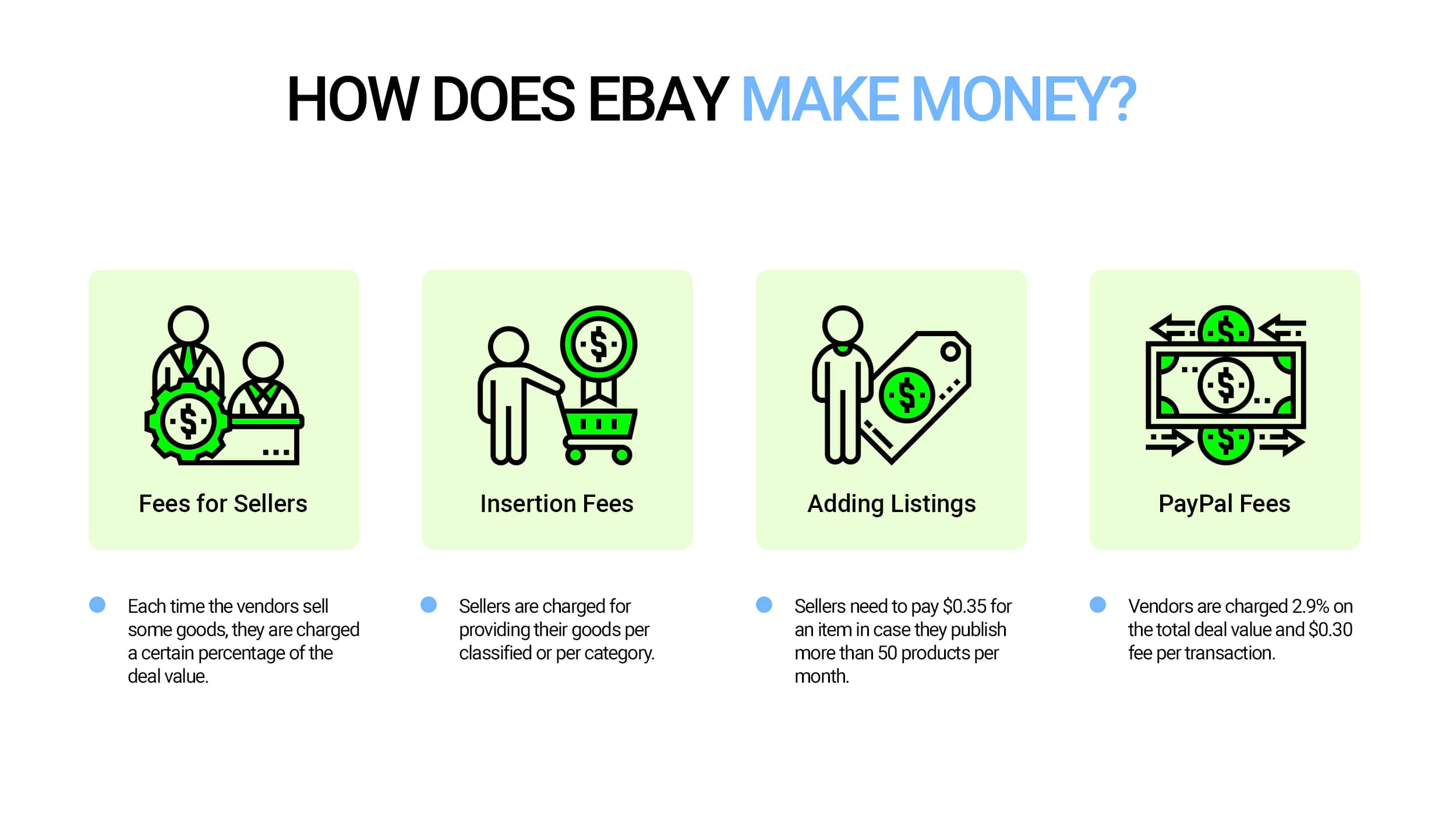
An elaborate business model is crucial in the making of successful online auction business. It is important to make sure that you take the time and effort to study your business model before anything else.
If you have finally made up your mind about making your own online auction, then read on as we give you the necessary details for the development process and warn you of the possible challenges you may face along the way.
How to build an online auction site: your step by step guide
Before starting directly with the development process, take note of every detail with regards to how the future auction will work and who exactly will be the target audience of the business. We have already talked about the possible business model and monetization scheme above, now we must go into detail about the important points that need to be considered before moving to the development stage proper.
Step 1: Define the type of your future auction
Before anything else, identifying the most suitable type of auction is important as this will set the tone of the whole process.
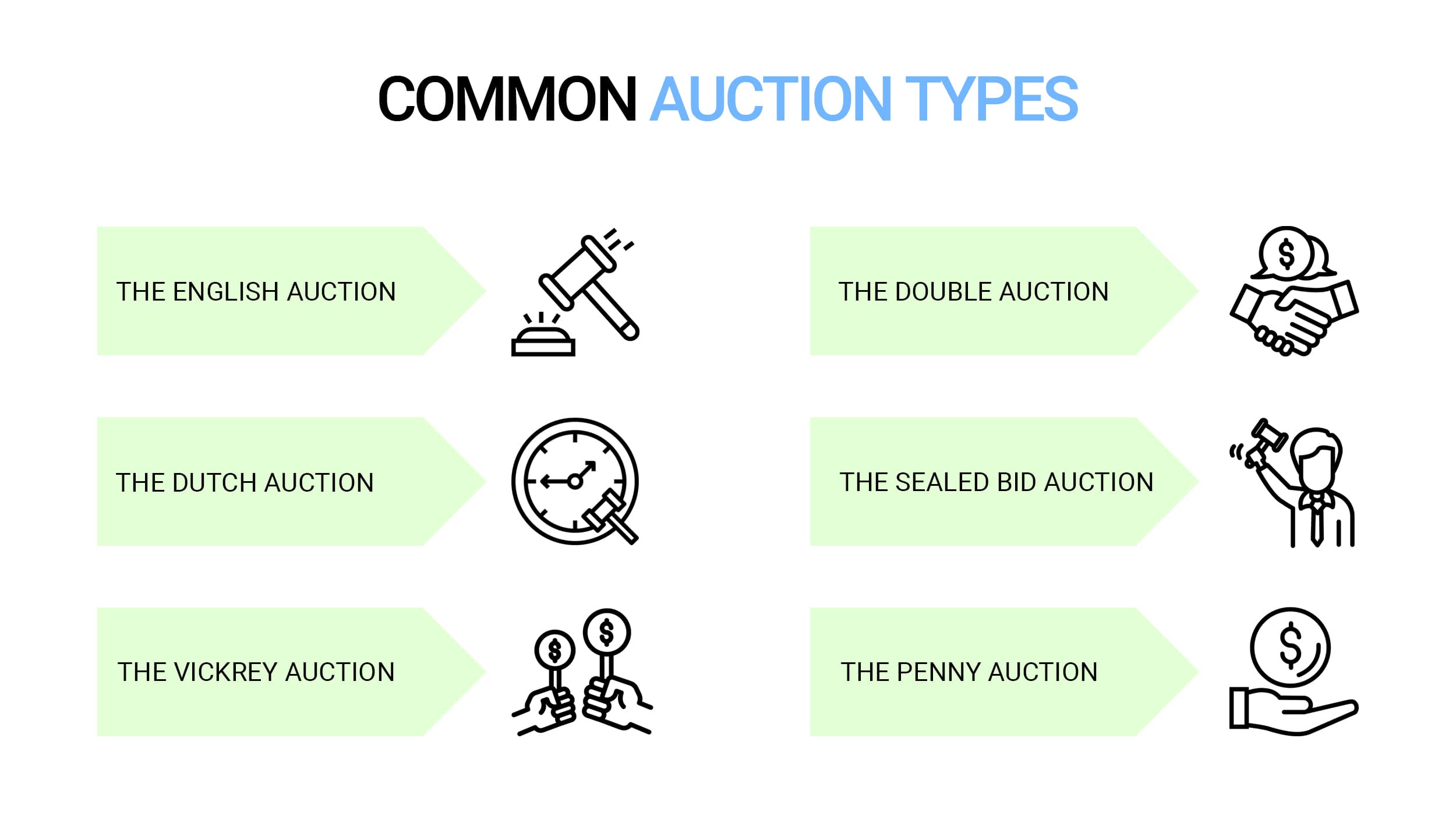
✓The English Auction – This is known to be the most common format of auctions wherein the bid starts at a reserve price and the bids take place in ascending order. The goods are considered sold to the highest bidder.
✓The Dutch Auction – Usually, this type of auction is aided with a button that stops an automatic clock or when a buyer claims an item by saying “mine”. The bidding of items starts especially at an incredibly high price and is progressively lowered as the bidding goes. The first winner takes the goods and pays at a higher price, and succeeding winners pay for less.
✓The Vickrey Auction – Named after the 1996 Nobel Prize in Economics winner, William Vickrey, this type of auction is when the goods will be given to the highest bidder but will only have to pay the second-highest bidder price. For instance, there are three bids $100, $80, $50—the goods are auctioned to the bidder who proposed $100 but will only have to pay $80.
✓The Double Auction – With this type of auction, the sellers, and buyers both would submit their desired price to an auctioneer who then chooses one price that clears the market. The sellers with a lesser asking price than the price set by the auctioneer will be allowed to sell, and the buyers who placed a bid higher than the price can buy at the price set.
✓The Sealed Bid Auction – Here, buyers can only bid once, and their bids are sealed. Once bidding is done, the sealed bids are opened and depending on the rules, the highest bidder wins (in other circumstances, the lowest bid wins).
✓The Penny Auction – This type of auction is set at a minimum amount. Bidders then can bid with fixed small increments from the starting price as many times as they want. As long as there are people bidding, the auction time is extended. When there are no bidders anymore, the time for the auction will run out and the last bidder is considered the winner.
Step 2: Define the necessary user roles
The timing and price of the auction web development process depend on different people. This is why it is important to identify the necessary user roles you would want to be part of your online auction. Aside from that, the platform you will be creating is meant to make sure that the relationship between the buyers, sellers, and administrators are harmonious. Hence, the site must support these roles:
- The Seller – creating an account, opening an account, using payment services, being able to monitor the progress of the auction, accept payments from different people, view and review the sales statistics and ratings are some of the most important things a seller must be able to do on the auction platform.
- The Buyer – buyers or participants must be able to create an account, open an account and use payment services, view different listings, search specific products, make bids, make payments for different transactions, leave review or feedback of sellers, view statistics and ratings of both the buyer and seller.
- The Administrator – the administrator must be able to moderate the auctions, check bids, user profiles, and content of the website.
Step 3: Define the feature list of your future online website
Feature lists and functions for online auction websites are vast and a lot can be applied. However, here are the key roles and their basic functions that you should know.
For the Seller
Listing Creation – Items or lots should easily be added by the seller together with all its information such as name, description, category, and images. Auction process requirements such as format, duration of the auction, currency, quantity of lots of items in stock, starting price, reserve price, payment options, and shipping details should also be included. Once all this information is provided, the system can now start creating lot listing availability in the search to bidders. The seller must also have the option to set different rules such as restricting auction time and minimum sum for the next bidder, for all the bidders to see.
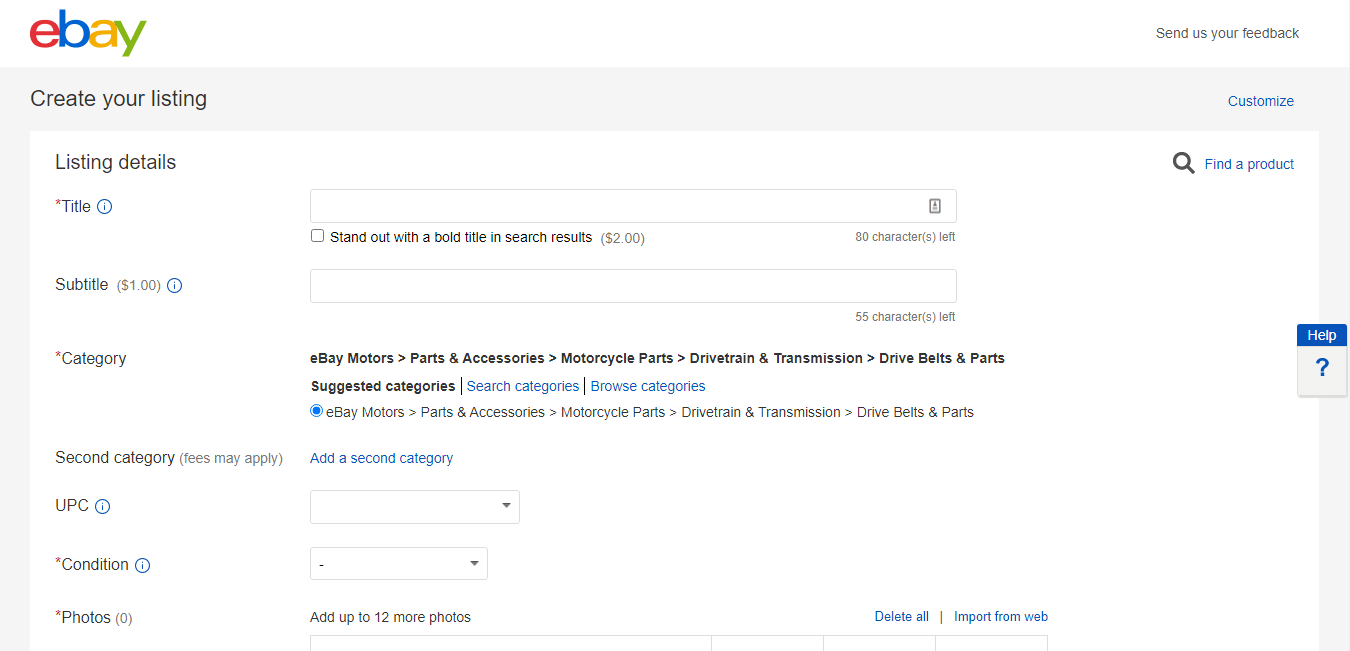
Seller Dashboard – this is a key feature for vendors as they are provided an overview of their statistics like sales tendencies, income, together with traffic, ratings, and expenses. With this vital information, sellers can plan their business moves strategically.
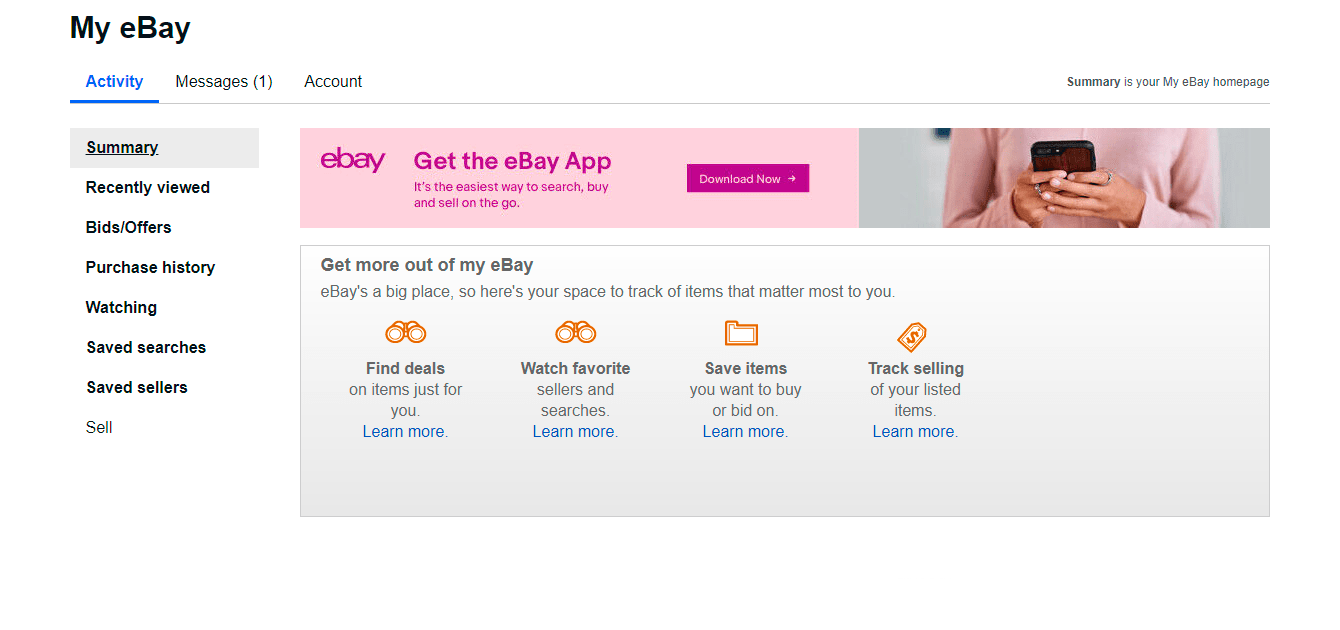
For the Buyer
User Profile – during the registration process, users should be able to add their personal information, shipping address, and payment details. It is also a wise choice to add other settings for notifications, messages, purchase history, recently viewed items, saved items, sellers, watch lists, and current bids. This information helps both buyers and sellers have a better maximum experience on the auction website.
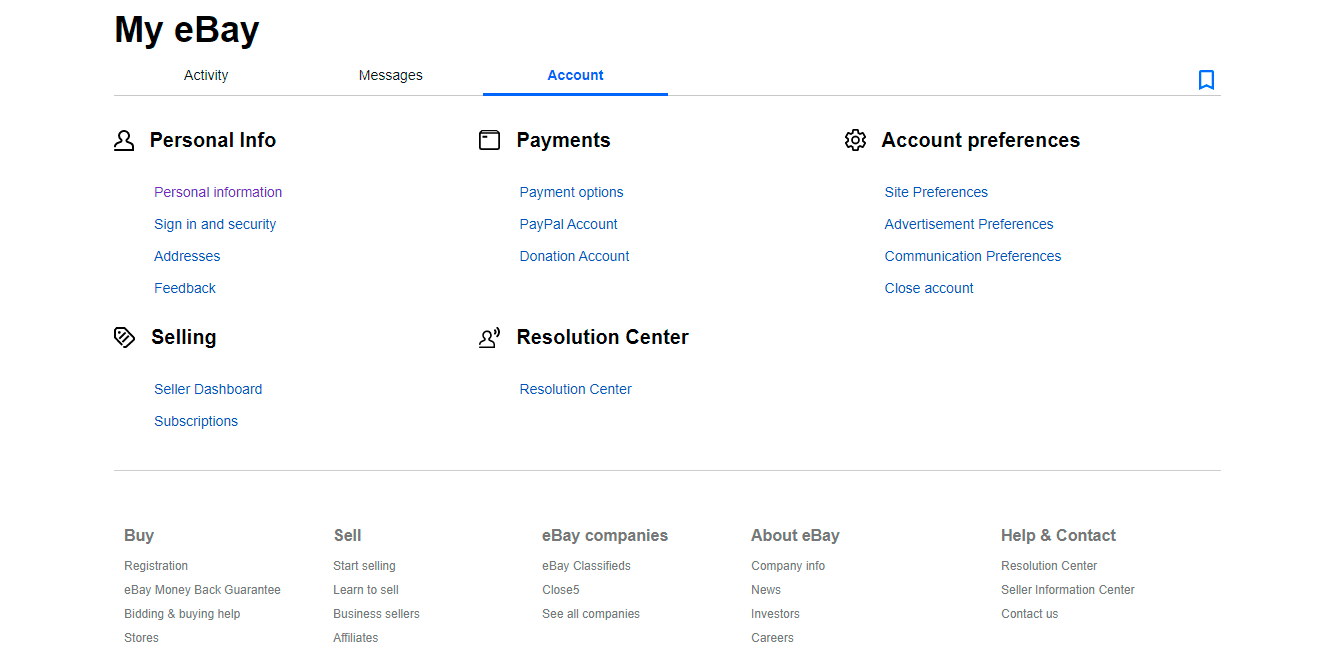
Product Search – it is important to provide the users with a variety of product and service categories made available in your online auction platform. Aside from it makes the users have a better experience, it also gives them easy access to find specific items they are looking for. Different advanced filters such as category, item condition, price range, buying format, seller, and shipping options are both useful and helpful.
Product Page – this should allow the users to see all the important details about the item including payment, shipping, delivery information, and seller’s contact details.
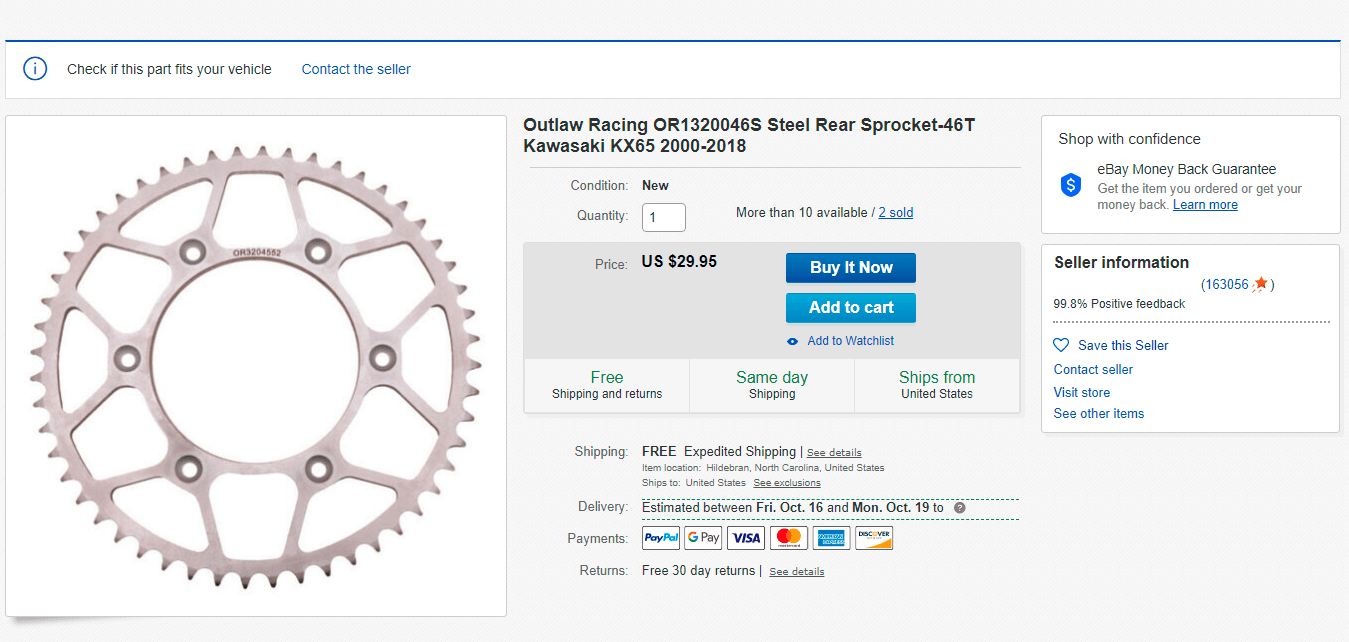
Bidding Process – setting the bidding process is important for both sellers and buyers. If you decide on a live auction, the sellers can choose a starting price for listed items, and everyone interested can place bids. Once the auction is over, the items are sold to the highest bidder (depending on the rules you have set).
Shopping Cart – Having a shopping cart helps consumers to pick several items from different stores that allow them to purchase all the items in one transaction. It is helpful to provide shopping cart settings such as managing in-cart items, changing product quantity, and removing items.
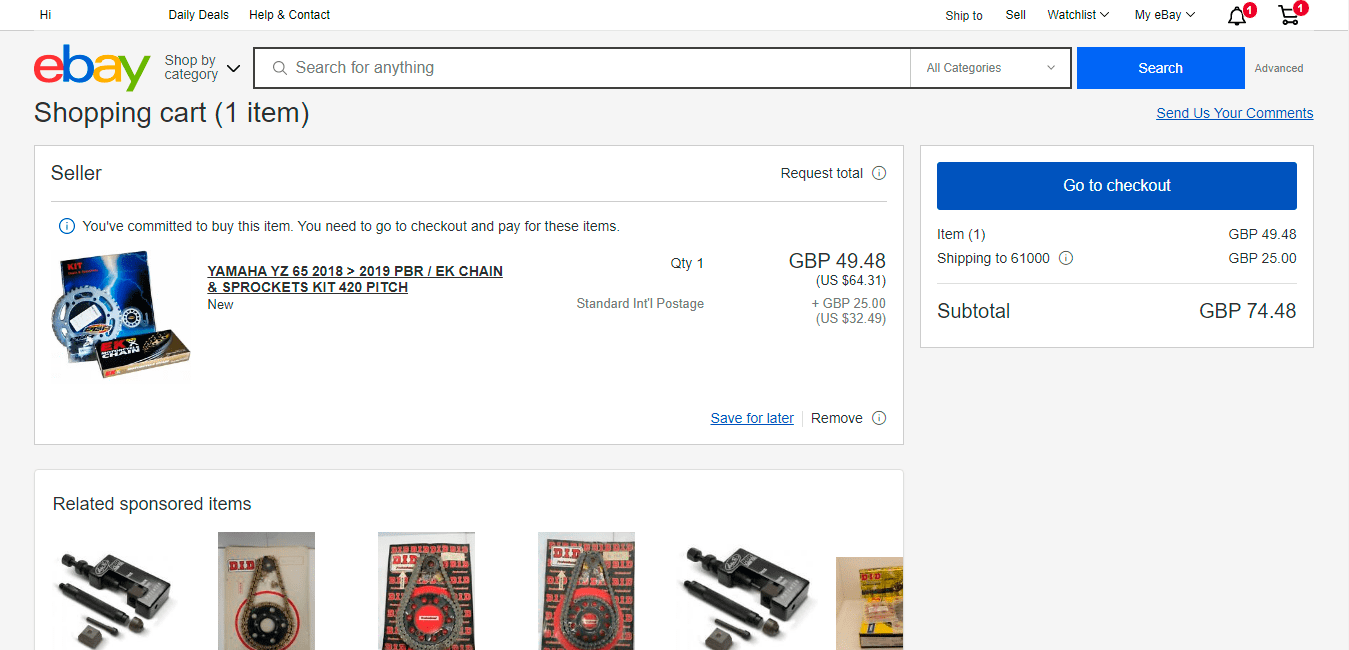
Integrations with Payment Methods – it is essential to have different payment methods on your platform. This helps both buyers and sellers to choose which option they prefer more such as credit or debit card, or PayPal. There are two options you can have, off-site integration and/or API integration. The off-site integration redirects the user to the payment method website, while the API integration has the option to pay the goods on your website with software integration.
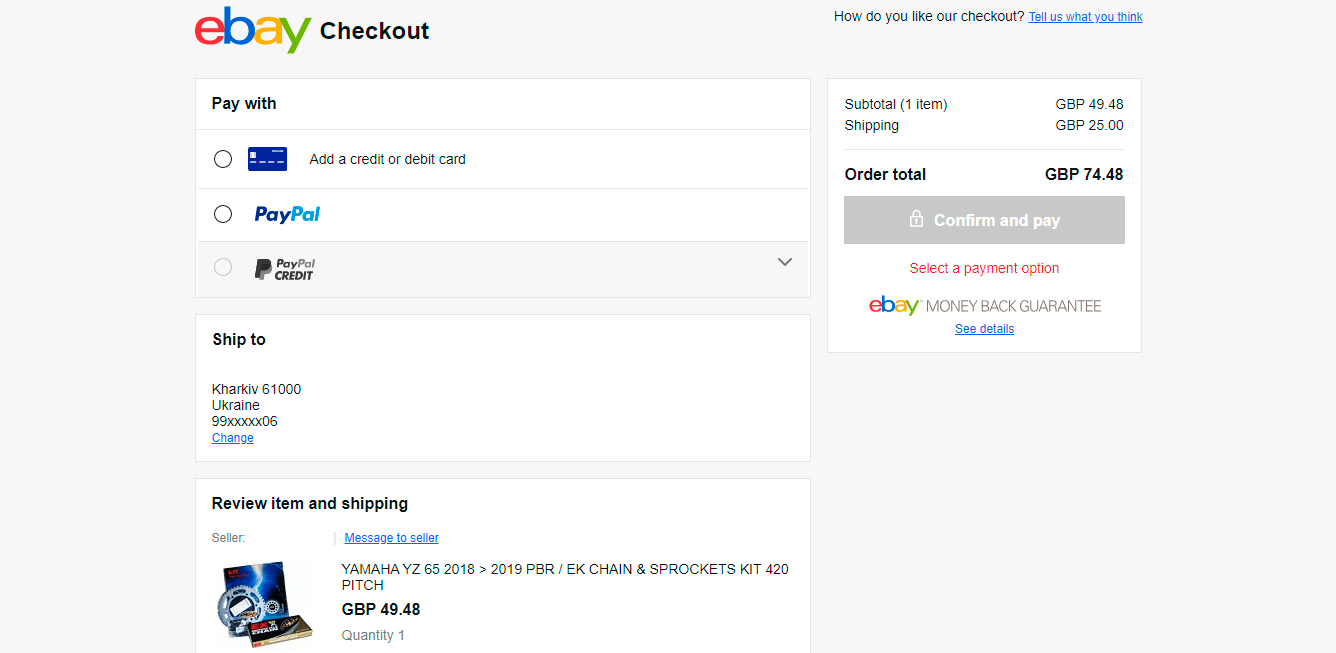
Ratings and Reviews – this helps both the seller and buyer have a clear view of sellers before deciding whether they want to get from this vendor or not. The customer and seller feedback for each transaction with ratings such as positive, neutral, or negative can help in future transactions.

Chat – having this feature is powerful. This also serves as an extension of the seller’s customer service which may also be a factor in their ratings. Buyers can easily communicate with the sellers when they need additional information about their products. It also builds a form of trust when both buyers and sellers can communicate fast and safely on your platform.
SuperAdmin Features
User Management – this provides the admin the power to edit and delete seller and buyer profiles depending on different circumstances.
Auctions and Bidding Management – admins have the ability to edit and delete auction bids especially if they go against the rules and regulations of the bidding system.
Content Management System – the ability to edit and delete any type of content especially when formats and rules are not followed, or community guidelines are not met.
Report Generation – admins can generate the report and how a particular product performed, together with the seller’s statistics.
Step 4: Define software or tech stack for your auction
One of the most important steps in creating an auction is deciding between Content Management System or Custom Website Development. Like any other, there will be advantages and disadvantages to both. That is why it is important to know the challenges and victories you will face when you decide which to choose.
Pros and Cons of a WordPress Auction Development
It does not always have to be a large-scale auction-based website that you have to go for. In fact, WordPress may be the best choice depending on who will use it, and how it will be used. Smaller-scale auction sites are unique and enable you to have more control over the items being auctioned which leads you to have a dedicated niche.
☑️Pros:
- the best for personal use, non-profit, event auctions, niche auction site
- lesser fees for both buyer and seller side
- provides an easier fix to development problems
☑️Cons:
- cannot compete against large-scale auction-based sites
- pretty tedious to work on the technical part and how the site will look since you have to do it yourself
- building the audience takes more effort than large-scale auction-based sites
Pros and Cons of a Custom Auction Development
Custom web development is great if you plan to expand the business and in need of specific features and/or 3rd party integrations.
☑️Pros:
- you can easily add specific functions and features, with the ability to personalize your website without thinking about templates that hinder your creativity
- it is a wise call for those who need high-performance applications and other applications that need real-time data changes
- it provides a higher speed compared to the ones built on WordPress
- provides better security for both sellers and users
☑️Cons:
- the development time for custom website building has a longer process than for a WordPress site. It will also take more time before the custom auction is live and ready to be used
- it is more expensive as it requires major technical expertise in different aspects such as design and development
How to choose technology for web development: 6 critical steps
Step 5: Start the auction web development process

It may be best to start with a Minimum Viable Product (MVP) development as it already has sufficient features that though minimal, is capable of meeting certain needs of users.
The development of a new platform has several stages, and many tasks are needed as the process progresses. Here are the following stages:
- Back-end Development – this includes all the processes that are visible to users. The different features and functionality are built in this process by back-end developers.
- Front-end Development – every single element of the web page from its interface, buttons, scroll buttons to the whole aesthetics is created by the front-end team.
- Prevent Security Issues – since payments are essential when it comes to auction sites, it is important to make sure that an SSL certificate is obtained. This builds trust and relationships between sellers and buyers assuring that security will not be compromised.
- Platform Testing – once all features are laid out, it is time to test whether everything is running smoothly. Testing helps highlight challenges such as bugs and security concerns that might pose a threat in the future.
- Launch and Support – it is key to accompany the launch with different promotions that may help boost attention and sales. Potential users, especially sellers should be presented with the many benefits they will get on your platform.
How much does it cost to build an auction website?
We tried to give the most detailed list of points that need to be considered before hiring a dedicated team to develop a project and sign a contract. As usual, the cost of developing a website depends on the selected list of features, third-party integrations, and the complexity chosen of technologies. A specific amount is a little hard to point especially when creating an auction website. However, here are some examples that might give you an idea as to how much you will need in the process:
- When using WordPress, the cost might be about $3000 to $10000 US dollars per month of development.
- With medium complexity auction websites, it might cost about $20000 to $40000 US dollars for maintenance.
- Large-scale online auction websites with increased complexity will cost $50000 and above in development.
| Scope | Approx time, hours |
| 1. Project Start | |
| Initial backlog preparation | 16 |
| Project Schedule Preparation | 24 |
| Staging environment setup | 40 |
| 2. Development Section (Back-end) | |
| Ticket tracking system | 30 |
| Accounting | 70 |
| Add item | 24 |
| Remove item | 9 |
| Completed auction | 24 |
| Pricing and subscription | 36 |
| Profile setup and edit | 40 |
| Admin dashboard | 20 |
| 3. Development Section (Front-end) | |
| Ticket tracking system | 50 |
| Accounting | 50 |
| Navigation bar | 17 |
| Add item | 24 |
| Remove item | 24 |
| Profile setup and edit | 20 |
| Admin dashboard | 20 |
| 4. Stabilization and Delivery | |
| Prepare deployment docs | 24 |
| Prepare description docs | 64 |
| Production deployment (AWS EC2 + CI) | 44 |
| 5. Project management | |
| Backlog elaboration and maintenance | 40 |
| Planning meetings, review meetings | 47 |
| Project Management and communication | 69 |
| Quality Assurance, hours: | 148 |
| Total Development, hours: | 590 |
| Project Management, hours: | 236 |
| Total: | 974 |
Our experience in auction development
Code&Care has a wide variety of web development experience, especially in building auctioning platforms. However, most projects are under NDA which leaves us to only talk about a limited number of products we have done.
ReelDeal – is a global digital marketplace for trading TV and film rights with auctioning functions. Code&Care created the online bidding solution with three user roles (seller, distributor, buyer) and an admin panel for each of them. We added an opportunity to create listings, download video content, and create descriptions for sellers. The development team realized from scratch bidding and buying functions for buyers.

For a free consultation on online auction development, do contact us! We are always more than happy to share our expertise and accumulated experience with you.

Real Estate Website Development
How to Build a CRM Software
How to Create an E-commerce Website
Web Development Trends 2021
















Popular
Latest